Related Research Articles

Corn smut is a plant disease caused by the pathogenic fungus Mycosarcoma maydis. One of several cereal crop pathogens called smut, the fungus forms galls on all above-ground parts of corn species such as maize and teosinte. The infected corn is edible; in Mexico, it is considered a delicacy, called huitlacoche, often eaten as a filling in quesadillas and other tortilla-based dishes, as well as in soups.

The smuts are multicellular fungi characterized by their large numbers of teliospores. The smuts get their name from a Germanic word for 'dirt' because of their dark, thick-walled, and dust-like teliospores. They are mostly Ustilaginomycetes and comprise seven of the 15 orders of the subphylum. Most described smuts belong to two orders, Ustilaginales and Tilletiales. The smuts are normally grouped with the other basidiomycetes because of their commonalities concerning sexual reproduction.
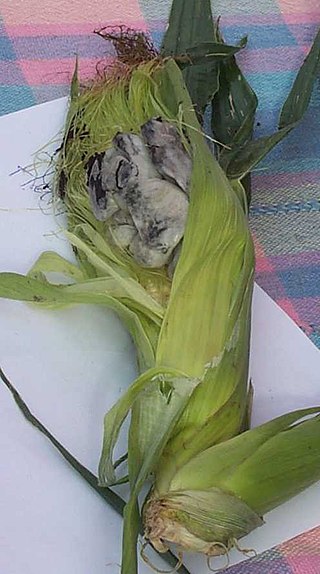
The Ustilaginales are an order of fungi within the class Ustilaginomycetes. The order contained 8 families, 49 genera, and 851 species in 2008.

The Ustilaginomycotina is a subdivision within the division Basidiomycota of the kingdom Fungi. It consists of the classes Ustilaginomycetes and Exobasidiomycetes, and in 2014 the subdivision was reclassified and the two additional classes Malasseziomycetes and Monilielliomycetes added. The name was first published by Doweld in 2001; Bauer and colleagues later published it in 2006 as an isonym. Ustilagomycotina and Agaricomycotina are considered to be sister groups, and they are in turn sister groups to the subdivision Pucciniomycotina.
Sporisorium sorghi, commonly known as sorghum smut, is a plant pathogen that belongs to the Ustilaginaceae family. This fungus is the causative agent of covered kernel smut disease and infects sorghum plants all around the world such as Sorghum bicolor (sorghum), S. sudanense, S. halepense and Sorghumvulgare var. technichum (broomcorn). Ineffective control of S. sorghi can have serious economic and ecological implications.
Sporisorium reilianum Langdon & Full., (1978), previously known as Sphacelotheca reiliana, and Sporisorium reilianum, is a species of biotrophic fungus in the family Ustilaginaceae. It is a plant pathogen that infects maize and sorghum.
Thecaphora is a genus of basidiomycote fungus which contains several species of plant pathogens. The widespread genus contained about 57 species in 2008. and held 61 species in 2020.
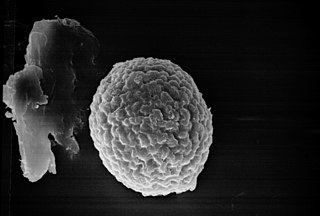
Tilletia is a genus of smut fungi in the Tilletiaceae family. Species in this genus are plant pathogens that affect various grasses. Tilletia indica, which causes Karnal bunt of wheat, and Tilletia horrida, responsible for rice kernel smut, are examples of species that affect economically important crops.

The Tilletiales are an order of smut fungi in the class Exobasidiomycetes. It is a monotypic order, consisting of a single family, the Tilletiaceae, which contains seven genera. The roughly 150 species in the Tilletiales all infect hosts of the grass family, except for species of Erratomyces, which occur on legumes.

The Ustilaginaceae are a family of smut fungi in the order Ustilaginomycetes. Collectively, the family contains 17 genera and 607 species.
The Cintractiellaceae are a monotypic, family of smut fungi, in the order Cintractiellales, but unplaced beyond that. The family contains one genera, Cintractiella with 4 species. The family was circumscribed by mycologist Kálmán Vánky in 2003.
The Melanotaenium is a genus of smut fungi in the family Melanotaeniaceae.
Aizoago is a fungal genus in the family Ustilaginaceae. Circumscribed in 2013, it contains two species of smut fungi found in Australia. Aizoago tetragoniae grows on Tetragonia diptera, while A. tetragonioides grows on Tetragonia tetragonioides.
Sporisorium is a fungus genus in the Ustilaginaceae family.

Kálmán Géza Vánky was a Hungarian mycologist with Swedish and Hungarian citizenship, who lived in Germany. He was considered to be the worldwide authority on the subject of smut fungi and has dominated the taxonomic study of Ustilaginomycetes for at least the past four decades.
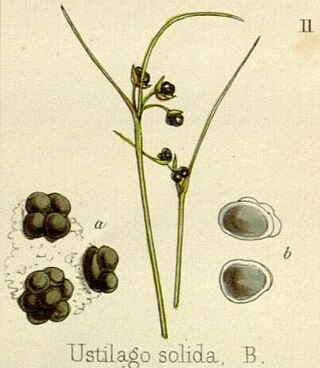
Cintractia is a genus of fungi belonging to the family Anthracoideaceae. It was first described by Marie Maxime Cornu in 1883.
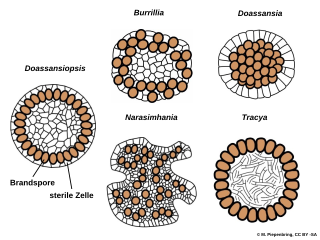
Doassansiopsis is a genus of smut fungi belonging to the monotypic family DoassansiopsidaceaeBegerow, R.Bauer & Oberw., 1998, within the class Ustilaginomycetes and order Urocystidales.
Farysia is a genus of fungi belonging to the family Anthracoideaceae.
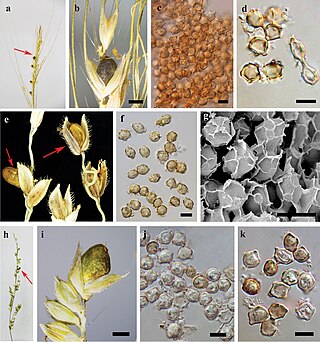
Moesziomyces is a fungal genus in the family Ustilaginaceae.

The Doassansiaceae are a family of fungi in the division Basidiomycota and order of Doassansiales. The family contains 11 genera and about 58 species. They have a widespread distribution. Doassansiaceae is also known and classified as a smut fungi.
References
- 1 2 3 4 5 6 7 A.R. McTaggart; R.G. Shivas; A.D.W. Geering; K. Vánky; T. Scharaschkin (2012). "Taxonomic revision of Ustilago, Sporisorium and Macalpinomyces". Persoonia. 29: 116–132. doi:10.3767/003158512X661462. PMC 3589789 . PMID 23606769.
- 1 2 3 "Macalpinomyces Langdon & Full". www.gbif.org. Retrieved 24 July 2022.
- ↑ Wang, Peng; Lu, Tianhao; Huang, Jingwei (2021). "The first complete mitochondrial genome of Macalpinomyces bursus (Ustilaginales: Ustilaginaceae) and insights into its phylogeny". Mitochondrial DNA Part B. 6 (8): 2151–2153. doi:10.1080/23802359.2021.1944383. PMC 8330779 . PMID 34377791.
- ↑ Burkhardt, Lotte (2022). Eine Enzyklopädie zu eponymischen Pflanzennamen [Encyclopedia of eponymic plant names](pdf) (in German). Berlin: Botanic Garden and Botanical Museum, Freie Universität Berlin. doi:10.3372/epolist2022. ISBN 978-3-946292-41-8. S2CID 246307410 . Retrieved January 27, 2022.
- 1 2 Douglas G. Parbery Daniel McAlpine and The Bitter Pit , p. 53, at Google Books
- ↑ Li, Yingming; Shivas, Roger; McTaggart, Alistair; Zhao, Peng (May 2017). "Ten new species of Macalpinomyces on Eriachne in northern Australia". Mycologia. 109 (3): 408–421. doi:10.1080/00275514.2017.1330026. hdl: 2263/63261 . PMID 28636469. S2CID 22108236.
- ↑ Bulgarian Mycological Society Mycologia Balcanica, Volumes 1-3 (2004) , p. 91, at Google Books
- ↑ Pedro W. Crous Phytopathogenic Fungi from South Africa (2000) , p. 192, at Google Books
- ↑ J. N. Srivastava and A. K. Singh (editors) Diseases of Field Crops Diagnosis and Management, 2-Volume Set: Volume 1 ... , p. 293, at Google Books
- ↑ Mohar Singh and Hari D. Upadhyaya Genetic and Genomic Resources for Grain Cereals Improvement (2015) , p. 341, at Google Books